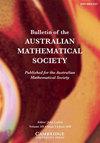求助PDF
{"title":"薄集的附加补全","authors":"JIN-HUI FANG, CSABA SÁNDOR","doi":"10.1017/s0004972723001016","DOIUrl":null,"url":null,"abstract":"Two sets <jats:inline-formula> <jats:alternatives> <jats:inline-graphic xmlns:xlink=\"http://www.w3.org/1999/xlink\" mime-subtype=\"png\" xlink:href=\"S0004972723001016_inline1.png\" /> <jats:tex-math> $A,B$ </jats:tex-math> </jats:alternatives> </jats:inline-formula> of positive integers are called <jats:italic>exact additive complements</jats:italic> if <jats:inline-formula> <jats:alternatives> <jats:inline-graphic xmlns:xlink=\"http://www.w3.org/1999/xlink\" mime-subtype=\"png\" xlink:href=\"S0004972723001016_inline2.png\" /> <jats:tex-math> $A+B$ </jats:tex-math> </jats:alternatives> </jats:inline-formula> contains all sufficiently large integers and <jats:inline-formula> <jats:alternatives> <jats:inline-graphic xmlns:xlink=\"http://www.w3.org/1999/xlink\" mime-subtype=\"png\" xlink:href=\"S0004972723001016_inline3.png\" /> <jats:tex-math> $A(x)B(x)/x\\rightarrow 1$ </jats:tex-math> </jats:alternatives> </jats:inline-formula>. For <jats:inline-formula> <jats:alternatives> <jats:inline-graphic xmlns:xlink=\"http://www.w3.org/1999/xlink\" mime-subtype=\"png\" xlink:href=\"S0004972723001016_inline4.png\" /> <jats:tex-math> $A=\\{a_1<a_2<\\cdots \\}$ </jats:tex-math> </jats:alternatives> </jats:inline-formula>, let <jats:inline-formula> <jats:alternatives> <jats:inline-graphic xmlns:xlink=\"http://www.w3.org/1999/xlink\" mime-subtype=\"png\" xlink:href=\"S0004972723001016_inline5.png\" /> <jats:tex-math> $A(x)$ </jats:tex-math> </jats:alternatives> </jats:inline-formula> denote the counting function of <jats:italic>A</jats:italic> and let <jats:inline-formula> <jats:alternatives> <jats:inline-graphic xmlns:xlink=\"http://www.w3.org/1999/xlink\" mime-subtype=\"png\" xlink:href=\"S0004972723001016_inline6.png\" /> <jats:tex-math> $a^*(x)$ </jats:tex-math> </jats:alternatives> </jats:inline-formula> denote the largest element in <jats:inline-formula> <jats:alternatives> <jats:inline-graphic xmlns:xlink=\"http://www.w3.org/1999/xlink\" mime-subtype=\"png\" xlink:href=\"S0004972723001016_inline7.png\" /> <jats:tex-math> $A\\bigcap [1,x]$ </jats:tex-math> </jats:alternatives> </jats:inline-formula>. Following the work of Ruzsa [‘Exact additive complements’, <jats:italic>Quart. J. Math.</jats:italic>68 (2017) 227–235] and Chen and Fang [‘Additive complements with Narkiewicz’s condition’, <jats:italic>Combinatorica</jats:italic>39 (2019), 813–823], we prove that, for exact additive complements <jats:inline-formula> <jats:alternatives> <jats:inline-graphic xmlns:xlink=\"http://www.w3.org/1999/xlink\" mime-subtype=\"png\" xlink:href=\"S0004972723001016_inline8.png\" /> <jats:tex-math> $A,B$ </jats:tex-math> </jats:alternatives> </jats:inline-formula> with <jats:inline-formula> <jats:alternatives> <jats:inline-graphic xmlns:xlink=\"http://www.w3.org/1999/xlink\" mime-subtype=\"png\" xlink:href=\"S0004972723001016_inline9.png\" /> <jats:tex-math> ${a_{n+1}}/ {na_n}\\rightarrow \\infty $ </jats:tex-math> </jats:alternatives> </jats:inline-formula>, <jats:disp-formula> <jats:alternatives> <jats:graphic xmlns:xlink=\"http://www.w3.org/1999/xlink\" mime-subtype=\"png\" xlink:href=\"S0004972723001016_eqnu1.png\" /> <jats:tex-math> $$ \\begin{align*}A(x)B(x)-x\\geqslant \\frac{a^*(x)}{A(x)}+o\\bigg(\\frac{a^*(x)}{A(x)^2}\\bigg) \\quad\\mbox{as } x\\rightarrow +\\infty.\\end{align*} $$ </jats:tex-math> </jats:alternatives> </jats:disp-formula> We also construct exact additive complements <jats:inline-formula> <jats:alternatives> <jats:inline-graphic xmlns:xlink=\"http://www.w3.org/1999/xlink\" mime-subtype=\"png\" xlink:href=\"S0004972723001016_inline10.png\" /> <jats:tex-math> $A,B$ </jats:tex-math> </jats:alternatives> </jats:inline-formula> with <jats:inline-formula> <jats:alternatives> <jats:inline-graphic xmlns:xlink=\"http://www.w3.org/1999/xlink\" mime-subtype=\"png\" xlink:href=\"S0004972723001016_inline11.png\" /> <jats:tex-math> ${a_{n+1}}/{na_n}\\rightarrow \\infty $ </jats:tex-math> </jats:alternatives> </jats:inline-formula> such that <jats:disp-formula> <jats:alternatives> <jats:graphic xmlns:xlink=\"http://www.w3.org/1999/xlink\" mime-subtype=\"png\" xlink:href=\"S0004972723001016_eqnu2.png\" /> <jats:tex-math> $$ \\begin{align*}A(x)B(x)-x\\leqslant \\frac{a^*(x)}{A(x)}+(1+o(1))\\bigg(\\frac{a^*(x)}{A(x)^2}\\bigg)\\end{align*} $$ </jats:tex-math> </jats:alternatives> </jats:disp-formula> for infinitely many positive integers <jats:italic>x</jats:italic>.","PeriodicalId":50720,"journal":{"name":"Bulletin of the Australian Mathematical Society","volume":"220 2","pages":""},"PeriodicalIF":0.5000,"publicationDate":"2023-11-15","publicationTypes":"Journal Article","fieldsOfStudy":null,"isOpenAccess":false,"openAccessPdf":"","citationCount":"0","resultStr":"{\"title\":\"ADDITIVE COMPLETION OF THIN SETS\",\"authors\":\"JIN-HUI FANG, CSABA SÁNDOR\",\"doi\":\"10.1017/s0004972723001016\",\"DOIUrl\":null,\"url\":null,\"abstract\":\"Two sets <jats:inline-formula> <jats:alternatives> <jats:inline-graphic xmlns:xlink=\\\"http://www.w3.org/1999/xlink\\\" mime-subtype=\\\"png\\\" xlink:href=\\\"S0004972723001016_inline1.png\\\" /> <jats:tex-math> $A,B$ </jats:tex-math> </jats:alternatives> </jats:inline-formula> of positive integers are called <jats:italic>exact additive complements</jats:italic> if <jats:inline-formula> <jats:alternatives> <jats:inline-graphic xmlns:xlink=\\\"http://www.w3.org/1999/xlink\\\" mime-subtype=\\\"png\\\" xlink:href=\\\"S0004972723001016_inline2.png\\\" /> <jats:tex-math> $A+B$ </jats:tex-math> </jats:alternatives> </jats:inline-formula> contains all sufficiently large integers and <jats:inline-formula> <jats:alternatives> <jats:inline-graphic xmlns:xlink=\\\"http://www.w3.org/1999/xlink\\\" mime-subtype=\\\"png\\\" xlink:href=\\\"S0004972723001016_inline3.png\\\" /> <jats:tex-math> $A(x)B(x)/x\\\\rightarrow 1$ </jats:tex-math> </jats:alternatives> </jats:inline-formula>. For <jats:inline-formula> <jats:alternatives> <jats:inline-graphic xmlns:xlink=\\\"http://www.w3.org/1999/xlink\\\" mime-subtype=\\\"png\\\" xlink:href=\\\"S0004972723001016_inline4.png\\\" /> <jats:tex-math> $A=\\\\{a_1<a_2<\\\\cdots \\\\}$ </jats:tex-math> </jats:alternatives> </jats:inline-formula>, let <jats:inline-formula> <jats:alternatives> <jats:inline-graphic xmlns:xlink=\\\"http://www.w3.org/1999/xlink\\\" mime-subtype=\\\"png\\\" xlink:href=\\\"S0004972723001016_inline5.png\\\" /> <jats:tex-math> $A(x)$ </jats:tex-math> </jats:alternatives> </jats:inline-formula> denote the counting function of <jats:italic>A</jats:italic> and let <jats:inline-formula> <jats:alternatives> <jats:inline-graphic xmlns:xlink=\\\"http://www.w3.org/1999/xlink\\\" mime-subtype=\\\"png\\\" xlink:href=\\\"S0004972723001016_inline6.png\\\" /> <jats:tex-math> $a^*(x)$ </jats:tex-math> </jats:alternatives> </jats:inline-formula> denote the largest element in <jats:inline-formula> <jats:alternatives> <jats:inline-graphic xmlns:xlink=\\\"http://www.w3.org/1999/xlink\\\" mime-subtype=\\\"png\\\" xlink:href=\\\"S0004972723001016_inline7.png\\\" /> <jats:tex-math> $A\\\\bigcap [1,x]$ </jats:tex-math> </jats:alternatives> </jats:inline-formula>. Following the work of Ruzsa [‘Exact additive complements’, <jats:italic>Quart. J. Math.</jats:italic>68 (2017) 227–235] and Chen and Fang [‘Additive complements with Narkiewicz’s condition’, <jats:italic>Combinatorica</jats:italic>39 (2019), 813–823], we prove that, for exact additive complements <jats:inline-formula> <jats:alternatives> <jats:inline-graphic xmlns:xlink=\\\"http://www.w3.org/1999/xlink\\\" mime-subtype=\\\"png\\\" xlink:href=\\\"S0004972723001016_inline8.png\\\" /> <jats:tex-math> $A,B$ </jats:tex-math> </jats:alternatives> </jats:inline-formula> with <jats:inline-formula> <jats:alternatives> <jats:inline-graphic xmlns:xlink=\\\"http://www.w3.org/1999/xlink\\\" mime-subtype=\\\"png\\\" xlink:href=\\\"S0004972723001016_inline9.png\\\" /> <jats:tex-math> ${a_{n+1}}/ {na_n}\\\\rightarrow \\\\infty $ </jats:tex-math> </jats:alternatives> </jats:inline-formula>, <jats:disp-formula> <jats:alternatives> <jats:graphic xmlns:xlink=\\\"http://www.w3.org/1999/xlink\\\" mime-subtype=\\\"png\\\" xlink:href=\\\"S0004972723001016_eqnu1.png\\\" /> <jats:tex-math> $$ \\\\begin{align*}A(x)B(x)-x\\\\geqslant \\\\frac{a^*(x)}{A(x)}+o\\\\bigg(\\\\frac{a^*(x)}{A(x)^2}\\\\bigg) \\\\quad\\\\mbox{as } x\\\\rightarrow +\\\\infty.\\\\end{align*} $$ </jats:tex-math> </jats:alternatives> </jats:disp-formula> We also construct exact additive complements <jats:inline-formula> <jats:alternatives> <jats:inline-graphic xmlns:xlink=\\\"http://www.w3.org/1999/xlink\\\" mime-subtype=\\\"png\\\" xlink:href=\\\"S0004972723001016_inline10.png\\\" /> <jats:tex-math> $A,B$ </jats:tex-math> </jats:alternatives> </jats:inline-formula> with <jats:inline-formula> <jats:alternatives> <jats:inline-graphic xmlns:xlink=\\\"http://www.w3.org/1999/xlink\\\" mime-subtype=\\\"png\\\" xlink:href=\\\"S0004972723001016_inline11.png\\\" /> <jats:tex-math> ${a_{n+1}}/{na_n}\\\\rightarrow \\\\infty $ </jats:tex-math> </jats:alternatives> </jats:inline-formula> such that <jats:disp-formula> <jats:alternatives> <jats:graphic xmlns:xlink=\\\"http://www.w3.org/1999/xlink\\\" mime-subtype=\\\"png\\\" xlink:href=\\\"S0004972723001016_eqnu2.png\\\" /> <jats:tex-math> $$ \\\\begin{align*}A(x)B(x)-x\\\\leqslant \\\\frac{a^*(x)}{A(x)}+(1+o(1))\\\\bigg(\\\\frac{a^*(x)}{A(x)^2}\\\\bigg)\\\\end{align*} $$ </jats:tex-math> </jats:alternatives> </jats:disp-formula> for infinitely many positive integers <jats:italic>x</jats:italic>.\",\"PeriodicalId\":50720,\"journal\":{\"name\":\"Bulletin of the Australian Mathematical Society\",\"volume\":\"220 2\",\"pages\":\"\"},\"PeriodicalIF\":0.5000,\"publicationDate\":\"2023-11-15\",\"publicationTypes\":\"Journal Article\",\"fieldsOfStudy\":null,\"isOpenAccess\":false,\"openAccessPdf\":\"\",\"citationCount\":\"0\",\"resultStr\":null,\"platform\":\"Semanticscholar\",\"paperid\":null,\"PeriodicalName\":\"Bulletin of the Australian Mathematical Society\",\"FirstCategoryId\":\"100\",\"ListUrlMain\":\"https://doi.org/10.1017/s0004972723001016\",\"RegionNum\":4,\"RegionCategory\":\"数学\",\"ArticlePicture\":[],\"TitleCN\":null,\"AbstractTextCN\":null,\"PMCID\":null,\"EPubDate\":\"\",\"PubModel\":\"\",\"JCR\":\"Q3\",\"JCRName\":\"MATHEMATICS\",\"Score\":null,\"Total\":0}","platform":"Semanticscholar","paperid":null,"PeriodicalName":"Bulletin of the Australian Mathematical Society","FirstCategoryId":"100","ListUrlMain":"https://doi.org/10.1017/s0004972723001016","RegionNum":4,"RegionCategory":"数学","ArticlePicture":[],"TitleCN":null,"AbstractTextCN":null,"PMCID":null,"EPubDate":"","PubModel":"","JCR":"Q3","JCRName":"MATHEMATICS","Score":null,"Total":0}
引用次数: 0
引用
批量引用
ADDITIVE COMPLETION OF THIN SETS
Two sets $A,B$ of positive integers are called exact additive complements if $A+B$ contains all sufficiently large integers and $A(x)B(x)/x\rightarrow 1$ . For $A=\{a_1<a_2<\cdots \}$ , let $A(x)$ denote the counting function of A and let $a^*(x)$ denote the largest element in $A\bigcap [1,x]$ . Following the work of Ruzsa [‘Exact additive complements’, Quart. J. Math. 68 (2017) 227–235] and Chen and Fang [‘Additive complements with Narkiewicz’s condition’, Combinatorica 39 (2019), 813–823], we prove that, for exact additive complements $A,B$ with ${a_{n+1}}/ {na_n}\rightarrow \infty $ , $$ \begin{align*}A(x)B(x)-x\geqslant \frac{a^*(x)}{A(x)}+o\bigg(\frac{a^*(x)}{A(x)^2}\bigg) \quad\mbox{as } x\rightarrow +\infty.\end{align*} $$ We also construct exact additive complements $A,B$ with ${a_{n+1}}/{na_n}\rightarrow \infty $ such that $$ \begin{align*}A(x)B(x)-x\leqslant \frac{a^*(x)}{A(x)}+(1+o(1))\bigg(\frac{a^*(x)}{A(x)^2}\bigg)\end{align*} $$ for infinitely many positive integers x .

 求助内容:
求助内容: 应助结果提醒方式:
应助结果提醒方式:


